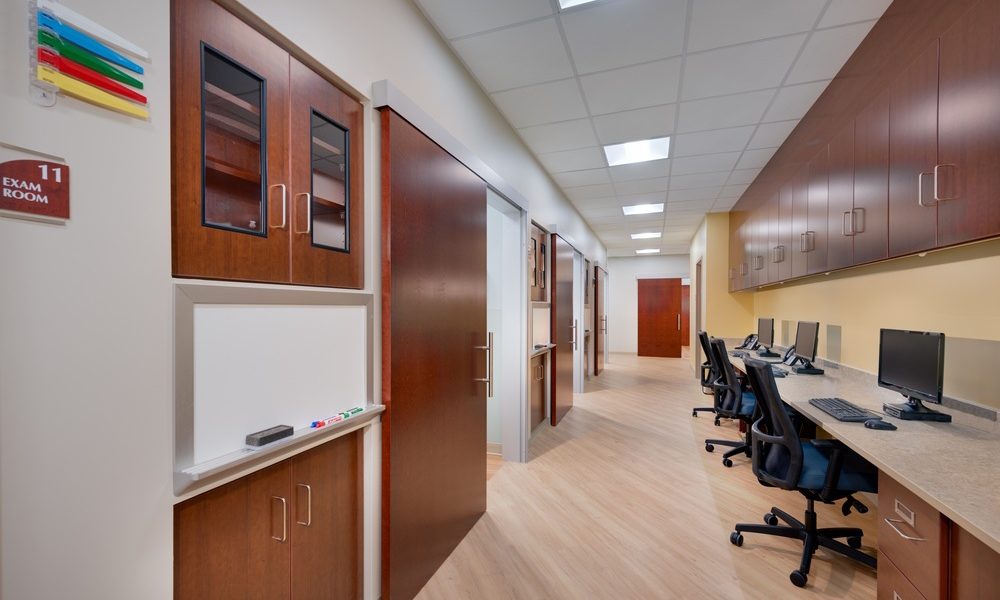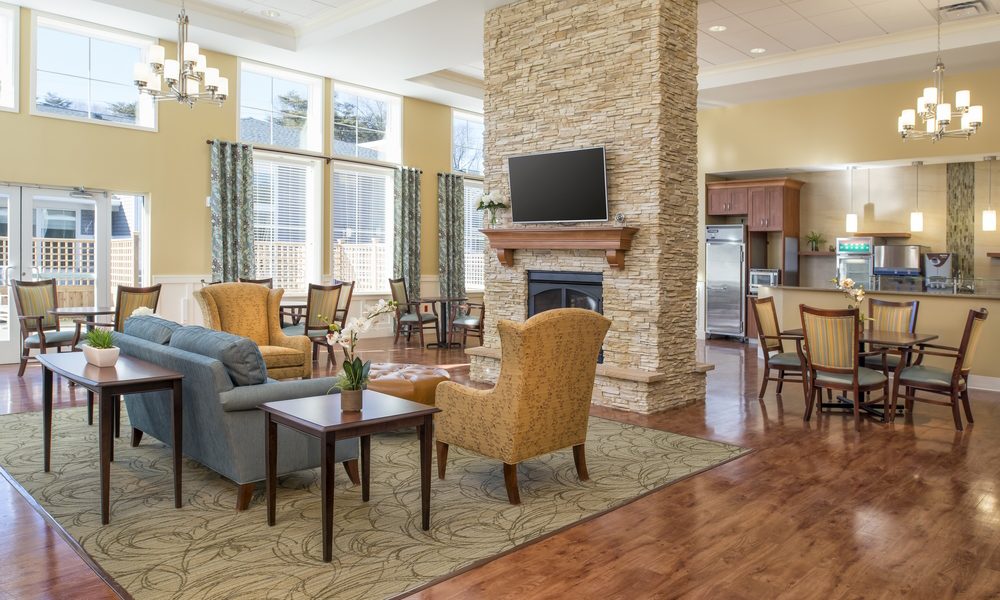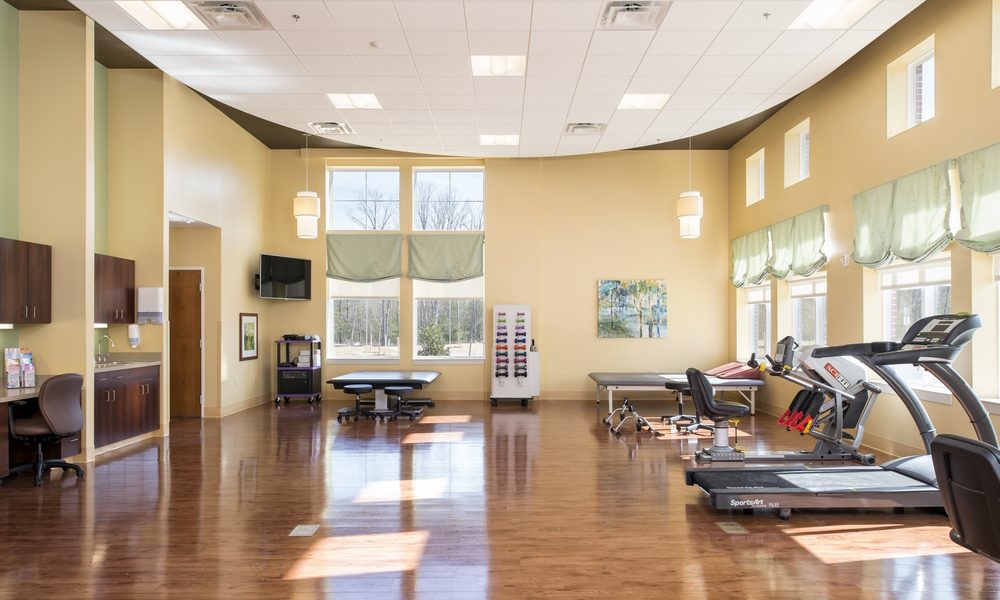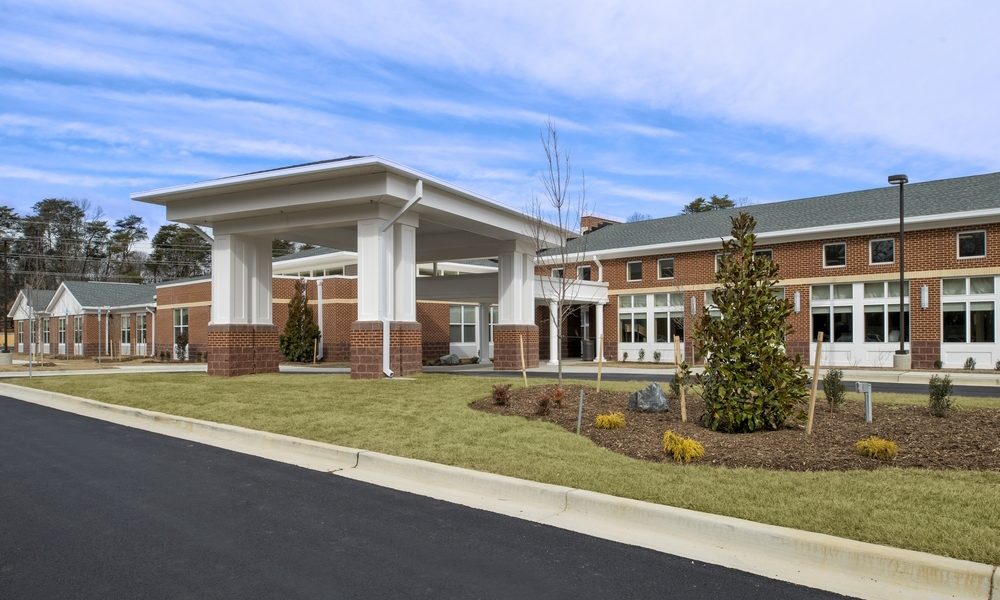 Typical outpatient medical staff work area and access, located opposite side of the exam rooms at Carroll Hospital Center Mt. Airy Outpatient Center, Mount Airy, Maryland. This illustrates outpatient facilities guidelines requirements are separate from the requirements for hospitals.
Typical outpatient medical staff work area and access, located opposite side of the exam rooms at Carroll Hospital Center Mt. Airy Outpatient Center, Mount Airy, Maryland. This illustrates outpatient facilities guidelines requirements are separate from the requirements for hospitals.  Activity/dining room at Restore Health Nursing Facility, Waldorf, Maryland, a skilled nursing facility sub-acute unit, rehabilitation services center and future assisted living facility, that illustrates the requirements of residential health, care and support facilities guidelines.
Activity/dining room at Restore Health Nursing Facility, Waldorf, Maryland, a skilled nursing facility sub-acute unit, rehabilitation services center and future assisted living facility, that illustrates the requirements of residential health, care and support facilities guidelines.  Rehabilitation therapy exercise gym at Restore Health Nursing Facility, Waldorf, Maryland, a skilled nursing facility sub-acute unit, rehabilitation services center and future assisted living facility, that illustrates the requirements of residential health, care and support facilities guidelines.
Rehabilitation therapy exercise gym at Restore Health Nursing Facility, Waldorf, Maryland, a skilled nursing facility sub-acute unit, rehabilitation services center and future assisted living facility, that illustrates the requirements of residential health, care and support facilities guidelines.  Restore Health Nursing Facility, Waldorf, Maryland, is a skilled nursing facility sub-acute unit, rehabilitation services center and future assisted living facility that illustrates the requirements of residential health, care and support facilities guidelines.
Restore Health Nursing Facility, Waldorf, Maryland, is a skilled nursing facility sub-acute unit, rehabilitation services center and future assisted living facility that illustrates the requirements of residential health, care and support facilities guidelines. Subscribe Now
Overview of the 2018 FGI Guidelines Revisions
By Patrick Schultz
The Facilities Guidelines Institute recently released the 2018 Edition of the Guidelines, which consist of three documents: Guidelines for Design and Construction of Hospitals; Guidelines for Design and Construction of Outpatient Facilities and Guidelines for Design and Construction of Residential Health, Care, and Support Facilities. Patrick Schultz, MCD board member, has prepared the following executive summary of each document as an easy reference tool pertaining to the current guidelines for the design and construction of healthcare facilities.
Guidelines for Design and Construction of Hospitals
Changes to the hospitals guidelines clarify the requirements of inpatient facilities separated from the requirements of outpatient facilities. Major revisions are described below.
General Planning and Design Considerations for Hospitals, a functional program is required for all projects, as is a safety risk assessment process to identify, monitor, control and mitigate risk. Acoustic design revises exterior noise classification and expanded exterior shell composite sound transmission ratings. And sustainable design provides new appendix guidance for a measurement and verification plan to track water use, gas, electricity and thermal energy by source. Finally, a new appendix provides guidance preparing for emergency preparedness assessment and planning for resiliency.
Common Elements for Hospitals introduces New Accommodations for Care of Patients of Size, which includes patients both clinically obese and non-clinically obese, but still of large size. Determining the projected need for patients of size is required to project the number of POS-designated spaces and need for expanded-capacity lifts. Designated-POS patient toilet rooms shall provide expanded-capacity toilet and either ceiling-based or floor-based lifts to support caregiver assistance.
Revised Pre- and Post-Procedure Patient Care provides hospitals the ability to combine all patient care stations (pre-procedure, phase I, phase II) into one area. Should a hospital choose to combine all patient care stations into one area, it must meet most restrictive requirements where combined in one area. Where pre- and post-procedure (recovery) patient care stations are combined into one patient area, at least two patient care stations per procedure, operating or class 2 or class 3 imaging room shall be provided in hospitals (and one in outpatient facilities). The benefit of combining into one area allows direct access to the semi-restricted areas without crossing unrestricted public corridors (applies to phase 1 only).
For Separate Patient Care Stations and Separate Pre-Procedure Room, one patient care station is required per imaging, procedure or operating room. Phase I PACU requires one per operating room (was 1.5), and Phase II recovery room requires one per imaging, procedure or operating room. Patient care stations can be bays, cubicles or single-patient rooms. Bays require 5 feet clear between gurney, 3 feet from adjacent walls and 2 feet from foot to cubicle curtain. Cubicles require 3 feet clear to adjacent walls, 2 feet from foot to the cubicle curtain, and where bays and cubicles face each other require 8 feet minimum clear aisle. Fully enclosed rooms require 3 feet clear from gurney to each side and foot.
Sterile Processing provides guidance to support cleaning and decontaminating by maintaining a one-way, dirty-to-clean workflow in sterile processing areas, with a two-room minimum sterile processing facility, consisting of decontamination room and clean workroom. Where small countertop sterilizers are used for limited workflow, a one-room sterile processing facility is permitted as an exception. Sterile processing for outpatient facilities is the same as hospitals.
Critical Care Patient Rooms revised where all patient rooms in critical care units (except NICUs), will be single-patient rooms with a minimum 200 square feet clear floor area and 13-foot-wide headwall per bed. Exception for renovation of patient rooms or cubicles for single-patient use with a 150 square feet minimum clear floor area.
Procedure and Operating Rooms aligns level of invasiveness of procedure and level of risk to patient. New appendix table determines which procedures are performed in each room type. Updated clearances for operating rooms and design guidance are provided to support different activities within the OR. New appendix expands guidance on determining OR size, layout and equipment used in operating rooms.
Procedure Rooms require a minimum 130 square feet clear floor area. Procedure rooms with anesthesia machine and supply carts require a minimum 160 square feet clear floor area. Procedure rooms must maintain minimum clear of 3 feet 6 inches at each side of table and 3 feet at head and foot of table. Where anesthesia machine and supply cart are used, 6 feet clear at head is required and, on the outside edge of the anesthesia work zone, 2 feet by 8 feet may serve part of circulation pathway.
Operating Rooms determine minimum clear floor area by combining the following clearances required for sterile field: 3 feet at side and foot of operating table, circulation pathway of 3 feet at both sides and 2 feet at foot of sterile field accommodating a movable equipment zone of 2 feet six inches on both sides and 2 feet at foot of the circulation pathway. The anesthesia work zone must provide 48 square feet at the head of table.
New Imaging Services and Rooms classification system, summarized in Appendix Table 2.2-2, outlines imaging room requirements and provides additional details for specific modalities.
Mobile Medical Units are revised based upon imaging classification system and requirements for class 1 exam and treatment rooms, class 2 procedure rooms and class 3 operating rooms.
Ventilation of Hospitals incorporates ASHRAE Standard 170 separately into each hospitals, outpatient facilities and residential healthcare guideline documents, making it easier to apply.
Guidelines for Design and Construction of Outpatient Facilities
Now separate from hospitals, outpatient facilities address both common design elements and specific requirements of project types ranging from medical offices to imaging centers, surgery, freestanding emergency, endoscopy, renal dialysis, psychiatric, rehabilitation, dental facilities and more.
2018 FGI applies a Two-Approach Method for Outpatient Guidelines intended to make its application more flexible. Approach 1 is for projects whose scope of services is “comprehensively described” in one of the specific facility type chapters in Part 2. Approach 2 is for projects whose scope of services are not directly described in a facility chapter, and include healthcare services for which one or more common elements and facility chapters may provide facility requirements.
A Functional Program is required for all new outpatient facilities with appendix guidance applying requirements including small outpatient facilities and tenant improvement projects. Outpatient facilities shall develop safety risk assessments per Appendix Table 1.2-1. Acoustic exterior noise classification shall apply to shell and core work only; tenant improvement projects are exempt. Outpatient sustainable design requires new plumbing fixtures and fittings comply with ASHRAE 189.3.
Similar to hospitals, outpatient facilities introduce new Accommodations for Care of Patients of Size, which must determine in the planning phase the number of POS-designated use spaces and expanded-capacity lifts required to serve its patient population. POS-designated exam rooms shall have 5 feet clear from edge of expanded-capacity table on transfer side when overhead lifts are available, and 7 feet clear from edge of expanded-capacity table on transfer side when no overhead lifts are available and 5 feet at foot of patient table or bed.
Examination Rooms shall include an exam table, recliner or chair placed at an angle. Each single-patient exam room shall have a minimum 80 square feet clear floor area, with 2 feet 8 inches clear at each side and foot of exam table. Specialty clinical services, which typically require larger exam rooms (e.g., ear, nose and throat or eye exam), must have a minimum 100 square feet clear floor area and 3 feet 6 inches clear at the side, head or foot of the exam table.
Procedure Rooms shall permit access from semi-restricted corridor or from unrestricted corridor. Procedure rooms shall provide a minimum 130 square feet clear floor area. Procedure rooms with anesthesia machine and supply cart shall have a minimum 160 square feet clear floor area with 3 feet 6 inches clear at each side, and 3 feet at head and foot of table.
Operating Rooms of 255 square feet and 270 square feet require the following for sterile field: 3 feet each side and foot, a circulation pathway and mobile equipment zone of 3 feet on both sides and 2 feet at foot of sterile field. Anesthesia work zones require 6 feet by 8 feet clear at head of operating table. A 400-square-foot operating room requires a sterile field of 3 feet each side and foot of operating table, a circulation pathway of 3 feet both sides and 2 feet at foot of sterile field and movable equipment zone of 2 feet 6 inches clear on both sides and 2 feet at foot of the circulation pathway. Anesthesia work zone requires the same 6 feet by 8 feet clear at head of operating table.
New Imaging Facilities classification system streamlines requirements and determines which applies to projects. General imaging room requirements are provided to apply to specific imaging modalities, including nuclear medicine and interventional imaging.
Outpatient Imaging Facilities chapter is reworked as outpatient imaging center, with basic requirements and cross-references to the common elements imaging (including nuclear imaging) and radiation therapy requirements in Chapter 2.1.
Urgent Care Facilities are revised for clinical space requirements for urgent care centers. Urgent care procedure rooms are now classified as treatment rooms, which will reduce some ventilation requirements.
Outpatient Surgery Facilities Procedure and Operating Room requirements are moved to the common elements chapter and are now cross-referenced from other chapters. Updated descriptions are provided for unrestricted, semi-restricted and restricted areas and support areas are reorganized to clarify their location within an outpatient surgery facility, in the semi-restricted area, directly accessible to the semi-restricted area or elsewhere in the facility.
Freestanding Emergency Care Facilities chapter appears in both 2018 Guidelines for Design and Construction of Hospitals and Guidelines for Design and Construction of Outpatient Facilities, respectively. Cross-references to emergency services section of the general hospital chapter were converted to actual requirements.
Endoscopy Procedure Rooms reduce minimum clear floor area from 200 square feet to 180 square feet. Requirements for endoscope processing room updated to reflect the “dirty-to-clean” workflow required for sterile processing facilities.
Outpatient Psychiatric Facilities requirements revised for consult rooms, group and observation rooms. Requirements added for exam, seclusion and quiet rooms for “space for a clear path of escape for staff” and a “staff assist device to communicate with others.”
Outpatient Rehabilitation Therapy Facilities exercise area revised to create “open, barrier-free space” for rehabilitation therapy to be sized according to number of patients treated at same time, and number of staff members present at same time and the clearance requirements for the equipment used.
Ventilation of Outpatient Facilities incorporates ASHRAE Standard 170. HVAC systems have three categories, 1) facilities must comply with ASHRAE 170, 2) room types must meet ASHRAE 170 and 3) facilities required to meet state and local building code requirements. Specifically, outpatient procedure and operating rooms must meet requirements of ASHRAE 170.
Guidelines for Design and Construction of Residential Health, Care, and Support Facilities
2018 FGI residential document emphasizes the provision of resident-centered care. Guidance is added to support application of resident safety risk assessment components to balance safety and risk mitigation, with a resident’s right to self-determination and approach to a resident’s overall quality of life. Many additions or revisions address the Centers for Medicare & Medicaid Services requirements to be eligible for reimbursement.
Care Consultation Areas residential patient consultation often takes place outside examination or treatment rooms. Minimum requirements have been introduced supporting the concept that care consultation areas, like residential environments themselves, should be more “homelike” and less “institutional.”
Grab Bars revised guidance provides for alternative configurations for swing-up grab bar placement at the toilet for 1-person and 2-person, or equipment-assisted transfers as compared to ADA-accessibility standards. Handrails and lean rails are expanded to include lean rails in long-term care settings, which often rely on lean rails or handrails to support resident mobility.
Accessible Showers must incorporate accessible standards to maximize resident independence. New appendix recommends a “zero” height threshold transition between shower and adjacent floor. ADA allows for transition height that can limit resident mobility and access to a shower.
Nursing Home Resident Units incorporates CMS publication “Reform of Requirements for Long-Term Care Facilities” affecting maximum capacity of nursing home resident rooms. A maximum of two persons is permitted in a resident room. Each room is required to have a bathroom with a toilet and sink. The 2018 edition no longer allows a bathroom to be located between two double-occupancy or two single-occupancy rooms that have separate resident room entry doors. The maximum number of occupants in a resident room after a renovation has changed from four to two people. This revised capacity allows facilities to remain compliant and eligible for reimbursement from CMS. New text requires nursing home rooms be configured so that each resident can view the television from a resident chair. Additional recommendations suggest dimensions for determining final space needs. Hospice room requirements are similar.
Post-Acute Care Facilities: new section with appendix information added to respond to changing reimbursement rules and shorter hospital stays. Post-acute care facilities are intended for residents receiving rehabilitation services rather than long-term or palliative care services.
Long-Term Residential Substance Abuse Treatment Facilities provides guidance for 24-hour therapeutic community settings providing for treatment and counseling of individuals with substance use disorders.
Settings for Individuals with Intellectual and Developmental Disabilities provides new guidance for intermediate care facilities for individuals with intellectual or developmental disabilities. While this chapter does not address larger residential health settings (nursing homes or hospitals) for residents with intellectual or developmental disabilities, this chapter is added due to the probability these facilities may be regulated as recipients of CMS reimbursement.
Adult Day Care Facilities, Support for Dining, Recreation, Lounge and Activity Areas relax the minimum requirement for location of toilet room to allow them to be located adjacent dining rooms, recreation, lounge or activity areas, rather than located by a specific set distance measured in linear feet.
Outpatient Rehabilitation Physical Therapy Exercise Area is revised for minimum space requirements to enhance the flexibility of services an organization provides to the care of the patient population it serves.
Conclusion
The FGI Guidelines will maintain its four-year renewal cycle for the 2022 edition, continuing to adjust to the healthcare industry’s changing needs. The views and opinions expressed in this article are the opinion of the author and not the official position of the FGI or of the organization’s Health Guidelines Revisions Committee. Please visit the FGI website to learn more about the 2018 FGI Guidelines documents, or to purchase a copy.
Photos courtesy of Jeffery Sauers Commercial Photographs.
Author: Patrick Schultz
Patrick Schultz, AIA, EDAC, LEED AP, is a principal with Waldon Studio Architects’ Healthcare Practice and a board member of MCD magazine. He can be reached at pschultz@waldonstudio.com.
Tags: 2018 FGI Guidelines Revisions, and Support Facilities, Architecture, Care, Facility Guidelines Institute, FGI, Guidelines for Design and Construction of Hospitals, Guidelines for Design and Construction of Outpatient Facilities, Guidelines for Design and Construction of Residential Health
Posted September 19, 2018
More Articles:
- Coverings 2024
Apr 22, 2024 – Apr 25, 2024 - Hospital, Outpatient Facilities & Medical Office Buildings Summit
Apr 25, 2024 – Apr 25, 2024 - CxA Workshop & Exam
Apr 29, 2024 – Apr 30, 2024 - EMP Seminar & Exam at CxEnergy 2024
Apr 29, 2024 – Apr 30, 2024 - CxEnergy
Apr 29, 2024 – May 2, 2024 - PHCC West 2024
Apr 29, 2024 – May 2, 2024 - Lean in Design Forum 2024
May 1, 2024 – May 2, 2024










